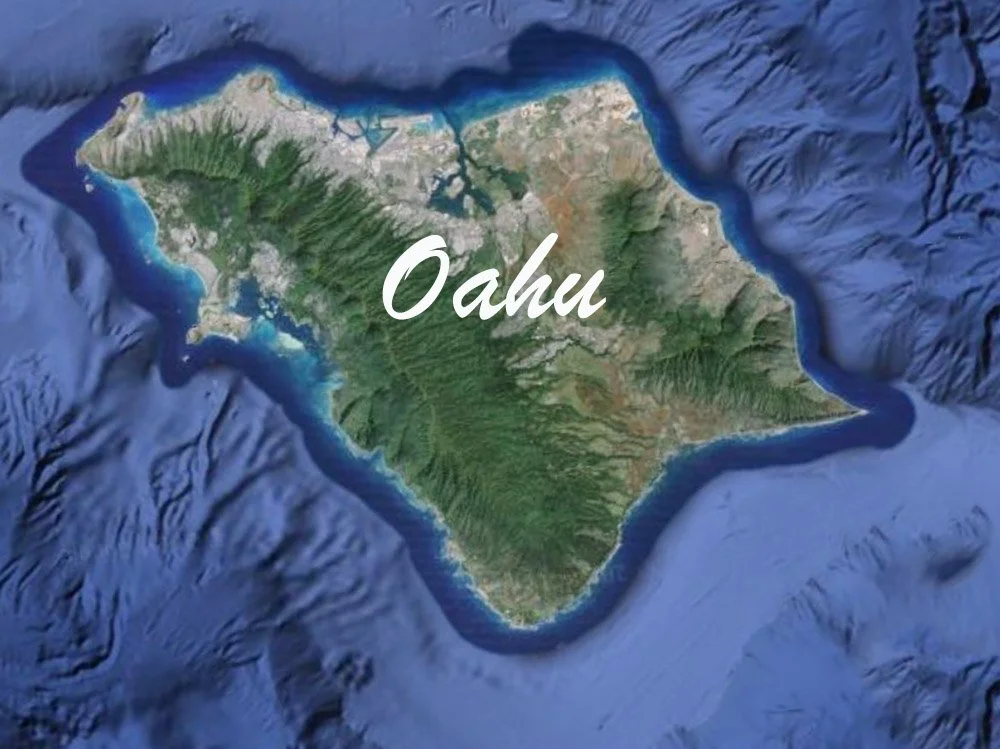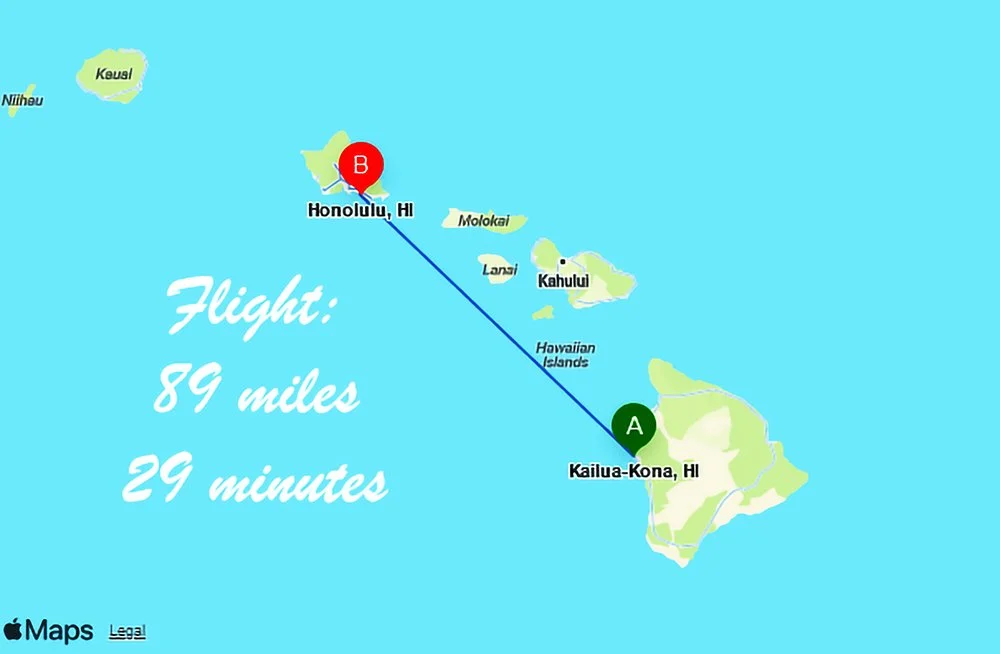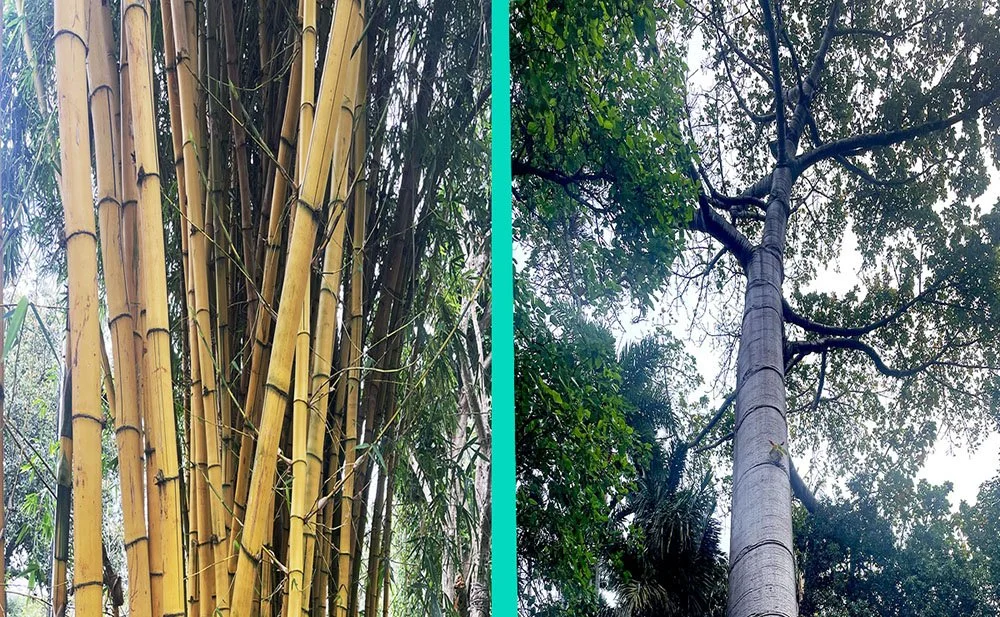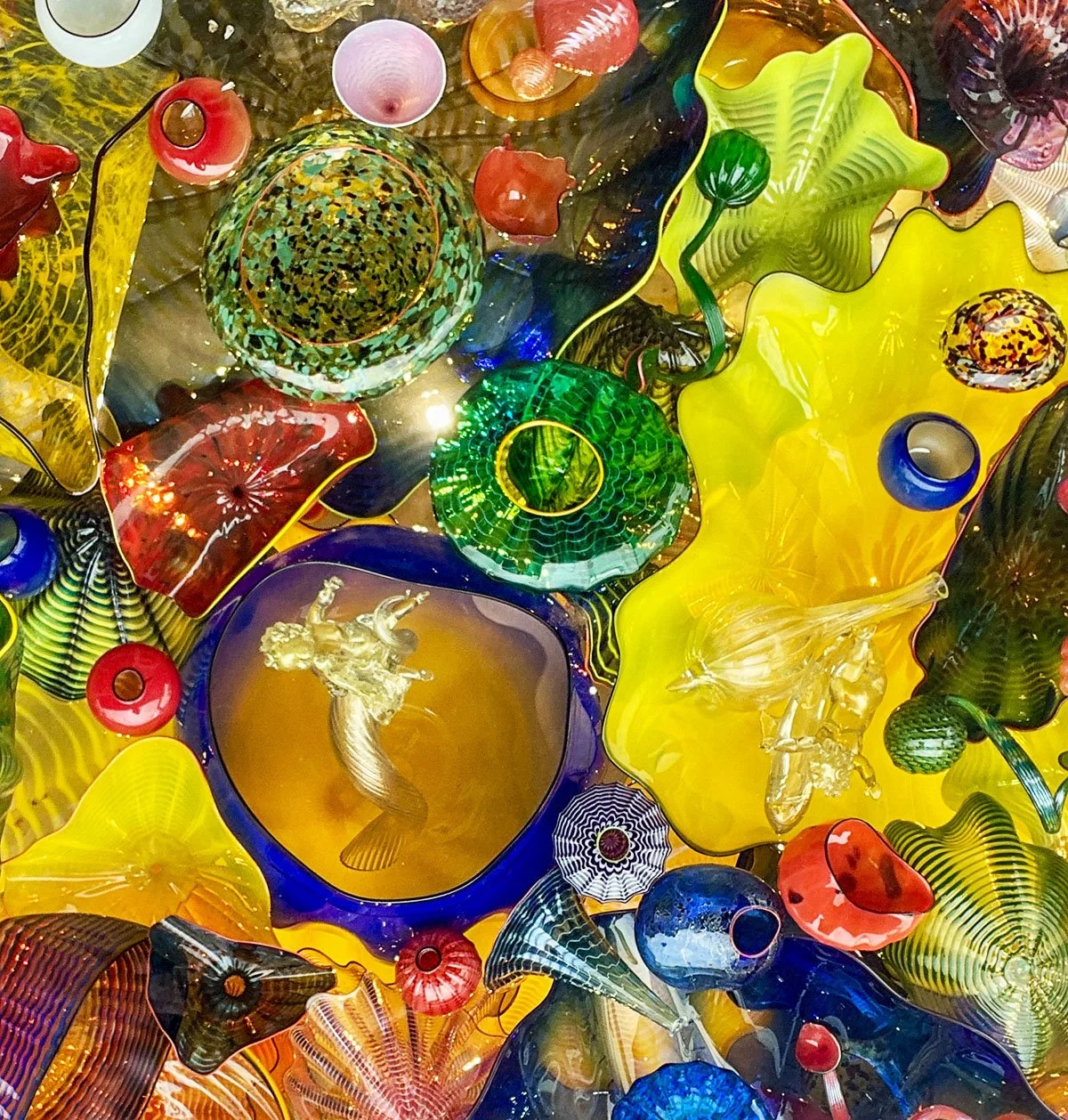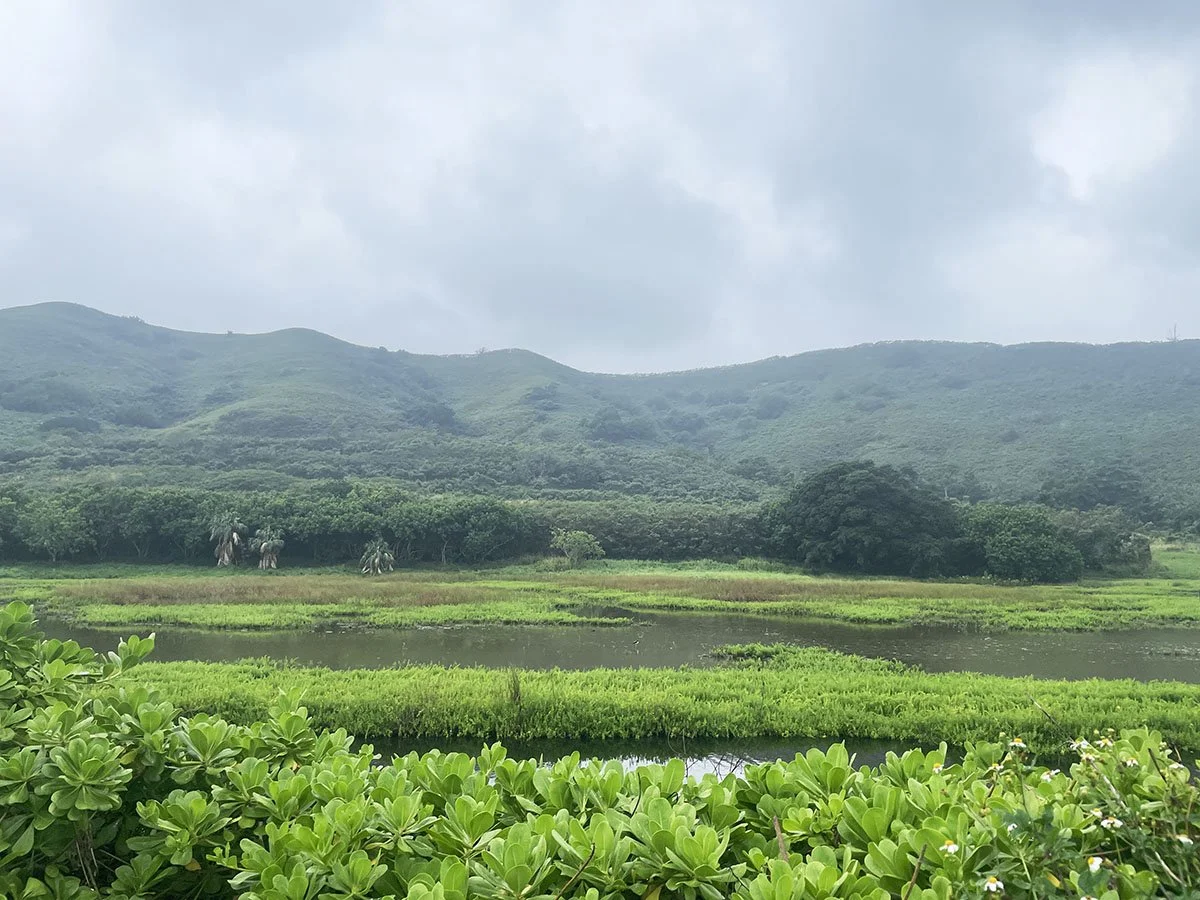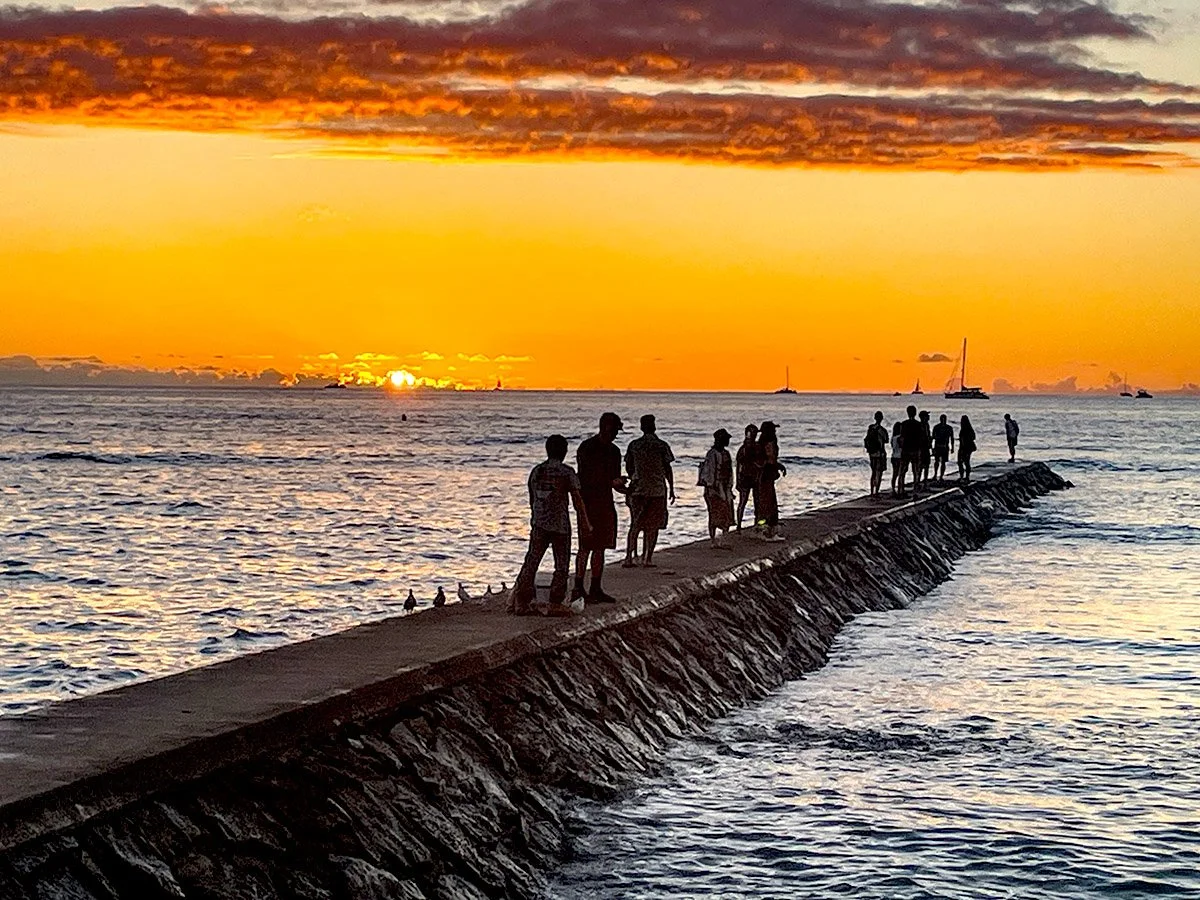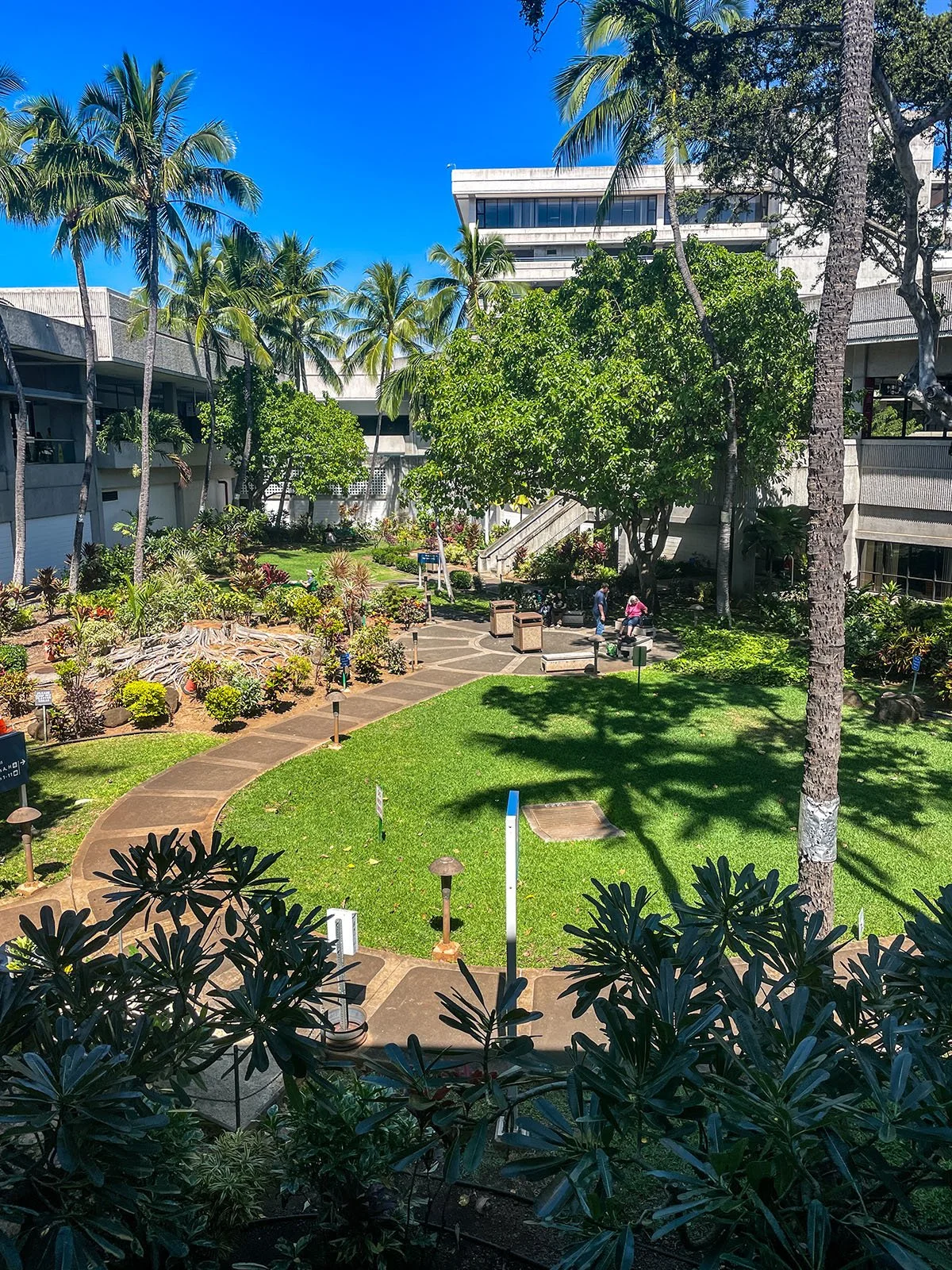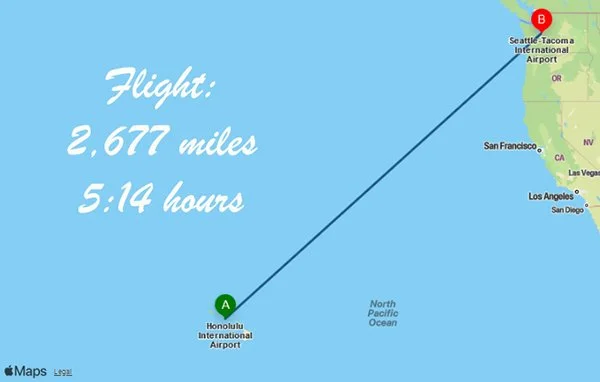Hawaiian Islands - Oahu
Satellite view, Oahu Island
Flight map, Kona-Honolulu
Kona’s airport is busy; passengers number approximately 200K monthly and 2M annually, with Los Angeles, Maui and Honolulu the top destinations.
After a short hop from Kona we landed at Honolulu’s airport, rented a car and merged onto H-1E. Bewilderment set in. After the Big Island’s lightly traveled roads, we were unprepared for Honolulu’s congested traffic. The car rental agent’s comments came to mind.
“Are you sure you don’t want Loss Damage Waiver (LDW) or Collision Damage Waiver (CDW)? Without LDW, you’ll be responsible for loss or damage to the car, including theft, and also could be charged for the car’s downtime while its out of the rental fleet.” “Nah, don’t need that,” I replied. Now, in the midst of Honolulu traffic, I began to question my “nah.”
Our Airbnb was a block off Waikiki’s iconic strip, Kalakaua Avenue. Sandwiched between two hostels and behind a hotel, the view wasn’t great, but free gated parking was a selling point. Plus, it was a short walk to the beach, the popular Barefoot Cafe, and the 300 acre Kapiolani Park, home to the Honolulu Zoo, play fields, tennis courts and more.
If you enjoy crowds, you’ll like the hotels and shops along Kalakaua Avenue. But if you prefer something quieter, then a stroll around Kapiolani Park is recommended. Also, in the neighborhood at the south end are a number of historic homes that warrant a look-see.
Hawaii’s four County governments—Honolulu, Kaua‘i, Maui and Hawai‘i—offer tax incentives to preserve historic owner-occupied residences that are designated on the State Register of Historic Places. The tax relief programs, which are similar in all four jurisdictions, provide that residences dedicated for historic preservation are exempt from general property taxes ($3.50 per $1,000 of assessed value), except for the payment of the annual minimum real property tax.
The Historic Hawai‘i Foundation was established to encourage the preservation of buildings, communities and sites relating to the history of Hawai‘i. Honolulu Tudor/French Norman Cottages Thematic Group are made up of fifteen different residences, built between 1923 and 1932. These homes display a high degree of craftsmanship and design detail. Some examples viewable during the neighborhood walk include:
(Upper Left) Built in 1923, Fred Harrison Rental Property is a one and a half story, ship lap sided, vernacular style house. It is a good example of a dwelling constructed as a middle class rental property. Although a modest house, it presents a distinctive appearance to the street with the curved, sweeping roof line; prominent bay window; double gabled ends on the west side; and a front doorway that does not face the street.
(Upper Right) C.W. Dickey Residence, built in 1926, is associated with the well-known local architect, Charles William Dickey, and the development of the Hawaiian style of architecture. This cottage, with its prominent double-pitched hipped roof, became the prototype for numerous modest cottages built in the Islands during the late 1920’s and 1930’s. Through the use of graceful sloping roofs, overhanging eaves, extensive windows and screened openings, and lanai. C.W. Dickey said, “I believe I have achieved a distinctive Hawaiian type of architecture” (Honolulu Advertiser, March 14, 1926). The house appears intact and serves as a well-crafted, well-designed statement of Dickey’s development of an exclusive Hawaiian style of architecture.
(Lower Left) The James J.C. Haynes Residence, built in 1926, is a two story, shingle sided house facing south. The house stands out as a well-constructed house, having been built by Lewers & Cooke, rendered in a distinctive colonial style distinguished by its high pitched, front facing gable roofs clad with cut shingles and closed eaves with 4" beaded tongue and groove soffits. The house is also significant for its adaptation of this colonial revival form to Hawai‘i’s climate. Its easy access to the outdoors bespeaks a Hawai‘i architectural tradition for informal living.
(Lower Right) The Egholm Residence was built in 1926 in the Diamond Head Terraces subdivision. It is significant as one of the few examples of a small cottage in the Spanish Colonial Revival style popular in Hawai‘i in the 1920’s and early 1930’s. The hipped red clay tile roof, stucco exterior and arcaded entrance are characteristic features of this style. The residence is the work of notable architect and builder Carl William Winstedt. The modest scale of this house is rare compared to the other palatial residences built in the Spanish Colonial Revival style during this time period in Hawai‘i.
Our “explore Honolulu day” included the:
Foster Botanical Garden, a peaceful oasis in the center of the city with wide paths, and an abundance of vegetation and benches to simply sit and enjoy the setting, and
Foster Botanical Garden, Honolulu
Foster Botanical Garden, Honolulu
the Art Museum of Honolulu with its friendly staff, outstanding exhibits, and an inner courtyard cafe.
Dale Chihuly’s 2001 “Reef”, Art Museum of Honolulu
Wahiawa Botanical Garden
A visit to the Wahiawā Botanical Garden was unplanned and thoroughly enjoyable. The 27-acre garden is approximately 26 miles and 38 minutes north of the Waikiki beach area. It is one of five gardens operated by the City and County of Honolulu. We spent an hour wandering the pathways, marveling at the tropical trees and plants, then crossing a bridge that spanned a deep ravine. We spoke with the friendly caretaker who welcomed us and noted that our early weekday visit conveniently avoided busy weekend crowds.
Wahiawa Botanical Garden
Our itinerary included a stop at Ted’s Bakery on the Kamehameha Hwy at Sunset Beach, for freshly baked pastries, supplemented with Costco Rotisserie chicken sandwiches prepared earlier in the morning. Afterwards, we continued along the two lane road, with a brief stop at the Turtle Bay Resort before traveling toward Kailua along the eastern shore of the island. For the first time during our entire visit, it rained, accounting for a vacant beach and the preserved and treasured Kaelepulu Wetland.
Honolulu to North Shore
Kailua Beach Park
Kaelepulu Wetland
Waikiki is renowned for its beautiful sunsets, and Nature did not disappoint.
Sunset, Waikiki
On our final morning we gassed up at the Alakawa Street Costco, bought take-out food from the nearby Bangkok Chef, returned the rental car (with a full tank and without a scratch), boarded a cute trolley for a short ride to the airport and passed through separate Customs and Agricultural checkpoints.
Waiting at airports is often a tedious experience, but that’s not the case at Honolulu’s Daniel K. Inouye International Airport. It features four peaceful and lightly visited garden areas.
C.B. Lansing Garden, Honolulu Airport
As the Airbus lifted off the runway, we took a last look at the Waikiki shoreline and Diamond Head.
Aloha and Mahalo, Hawai‘i!
Flight map: Honolulu to Seattle
Ready to visit the Islands?
VediSito’s Hawaii Family Travel Guide will help you plan your trip!
